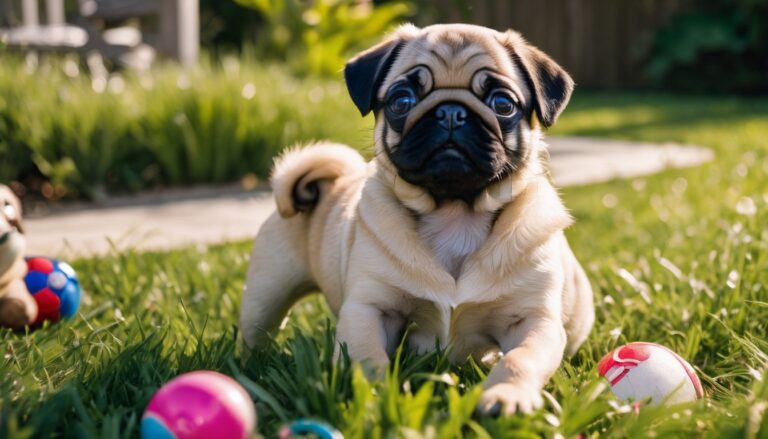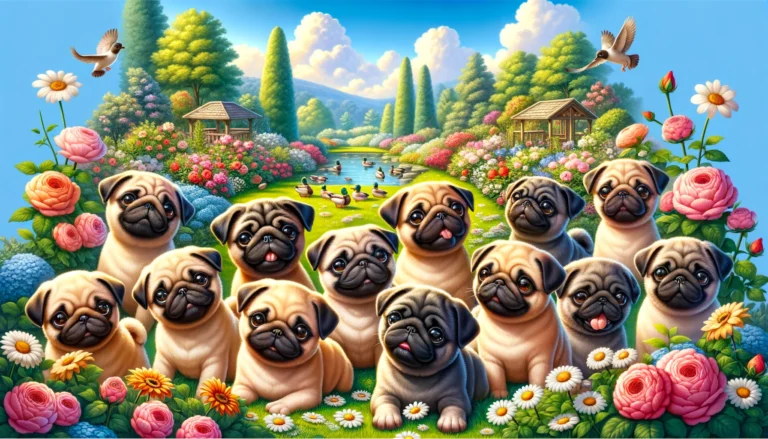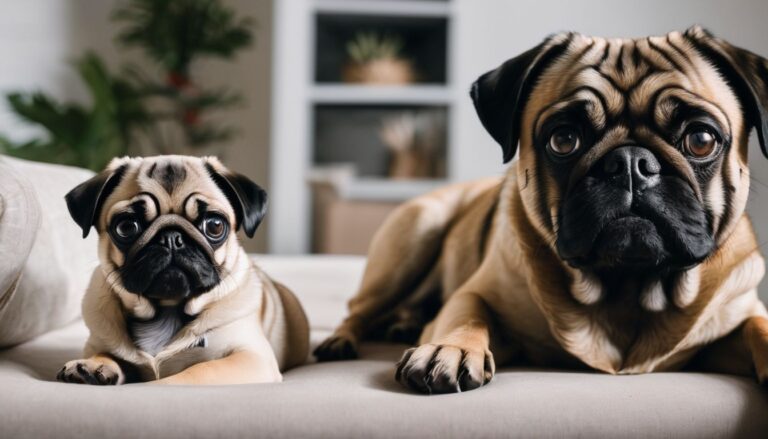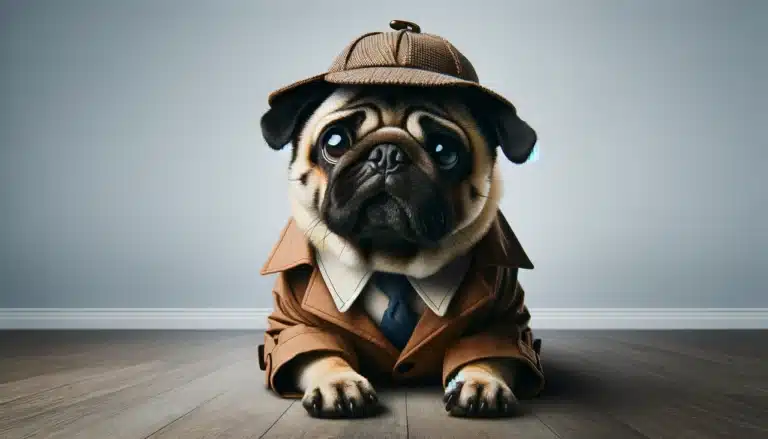Are Pugs Hyper? Exploring The Energy Levels And Calming Down Of Pugs
Have you ever found yourself marveling at your pug’s seemingly endless reserves of energy and thinking, “Is this normal?” Well, rest assured, you’re in good company with fellow pug lovers who’ve also witnessed their little companions’ lively spirits.
We’ve taken a deep dive into the whirlwind of puggish enthusiasm to figure out how best to channel that spunk within the framework of a well-adjusted lifestyle. Get ready for some fun revelations as we explore ways to sync up with your pug’s exuberant personality—time to get started on this exciting journey together!
Key Takeaways
- Pugs are known for their playful and energetic behavior, especially as puppies, but typically mellow out around two to three years of age.
- Puzzle toys, training exercises, and regular playdates can help channel a pug’s energy positively while providing mental stimulation to prevent boredom and hyperactivity.
- Regular exercise is essential for pugs; daily walks and moderate – intensity activities like fetch keep them healthy, but be mindful of their breathing difficulties due to being brachycephalic.
- Creating a safe space at home and practicing calm departures can ease a pug’s anxiety. Training routines also help reduce clinginess by fostering independence in the dog.
- Pugs enjoy companionship and thrive on attention from their owners. They may seem hyper when young but grow into affectionate, loyal pets that value both playtime and relaxation with their human family.
Are Pugs Hyper? Understanding Pugs’ Energy Levels

Pugs often exhibit bursts of energy and excitement, which can lead many to wonder if they fall on the hyper side of the canine spectrum. In reality, this vivaciousness is a part of their charm and points to a storied lineage that belies their compact size.
Pugs may seem hyper due to their playful nature
Pugs often burst with energy, especially as puppies. They dash around, eager to explore and play, showing off a cheerful zest for life that can easily be mistaken for hyperactivity.
Their love of fun means they’re always on the lookout for games or attention from us. As our furry companions zip around the house or yard, it’s their joyful spirit shining through.
We see this high-spirited behavior mellow out significantly by the time they turn two years old. Until then, these little dogs pack a lot of enthusiasm into every day. Puzzle toys can work wonders in channeling some of that exuberance into positive activities that provide both mental stimulation and physical exercise.
Regular sessions with these toys keep their minds engaged, help burn off extra energy and prevent boredom which might otherwise lead to restlessness or mischief.
An active legacy passed down from their ancestors
Our pug pals may be small, but their zest for life is huge, and it’s something they inherit from their ancestors. Picture them centuries ago: pugs served as companions to Buddhist monks in Tibet before mingling with high society in China.
These forebears spent hours playing and keeping watch, traits that trickle down to the playful pups we adore today. They’re not just lapdogs; they carry a spirited lineage that loves activity.
We see this legacy when our furry friends chase balls with abandon or play tug-of-war like there are world titles at stake. They inherited more than a wrinkled face and a curly tail; they got an enthusiasm for engagement that shines through every leap and bark.
Despite their snorty breaths, these dogs have hearts set on frolic – a testament to generations of vivacious vigor running through their veins.
The Role of Mental Stimulation and Training
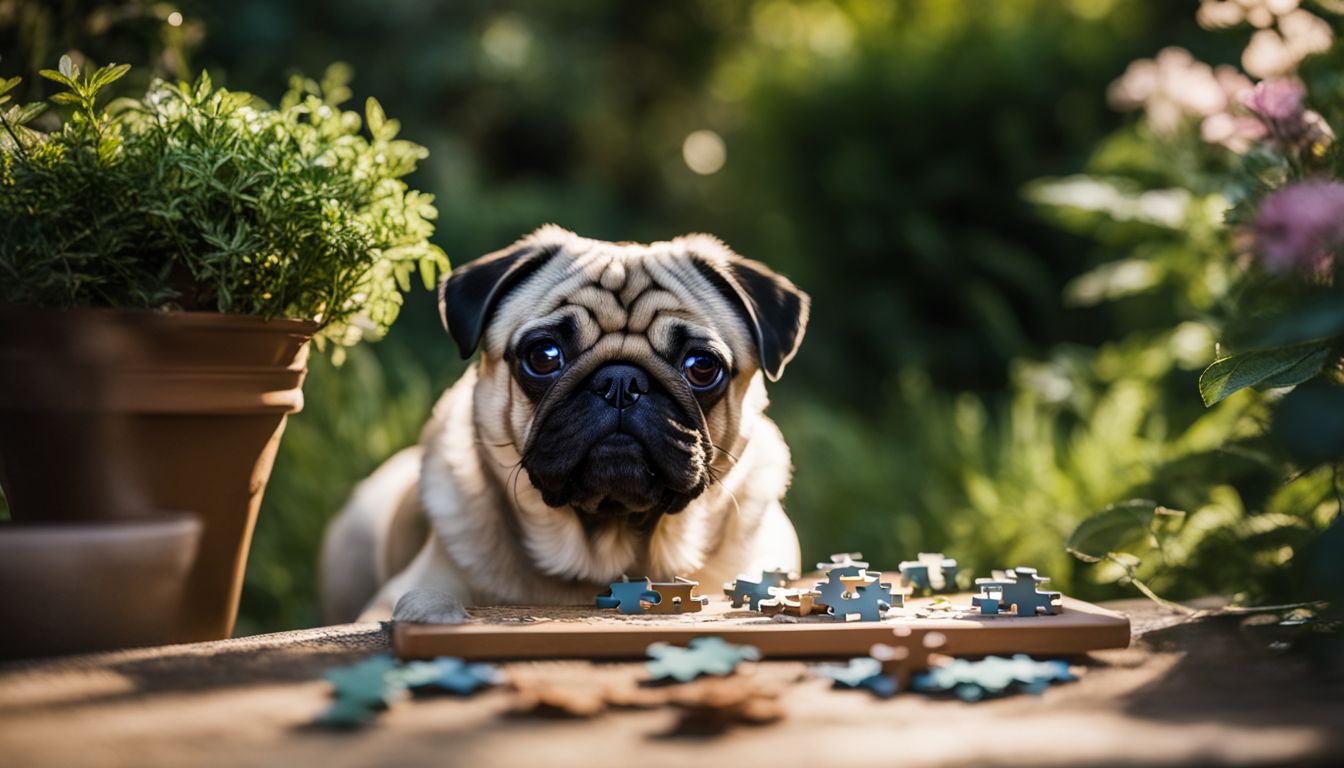
Pugs thrive on engaging their minds just as much as they do their bodies, so incorporating mental stimulation into their routine is key to managing any hyper tendencies. Through consistent training, we can channel their energy into positive behaviors and reinforce the loving companionship that pug owners cherish.
Providing mental exercise to calm hyperactivity
Mental exercise is crucial for calming a hyper pug. It engages their brain, reducing excess energy and improving overall behavior.
- Use puzzle toys: Puzzle toys are amazing to keep your pug mentally stimulated. Fill these toys with treats, and watch as your pug figures out how to get to the prize. This activity encourages problem-solving which is a great mental workout.
- Teach new tricks: Learning new commands and tricks keeps their mind active and focused. Use positive reinforcement during training sessions; this not only boosts their learning but also strengthens your bond.
- Provide variety: Just like humans, pugs can get bored with the same old routine. Introduce new games or change up their training exercises to keep things fresh and exciting for them.
- Schedule playdates: Pugs love socialization, so arrange playdates with other dogs. This interaction allows them to exercise both their bodies and minds as they communicate and play with peers.
- Interactive feeding: Turn meal times into an interactive session by using slow feeders or hiding portions of food around the house for them to find. This ‘hunting’ for food will give them a sense of purpose and tire them out mentally.
- Practice shaping behaviors: Shaping involves rewarding incremental steps towards a desired behavior—like teaching your pug to pick up toys. It’s an excellent way to enhance cognitive abilities while keeping training fun.
- Daily routines: Establishing consistent daily routines helps reduce anxiety in hyperactive pugs by providing predictability in their lives, allowing for more relaxed behavior.
- Obedience training: Engage in regular obedience training which helps instill discipline and focus in energetic pugs. Sessions led by professional dog trainers can be especially effective.
Importance of proper training for a well-behaved Pug
Just as mental exercise is vital for a Pug’s well-being, proper training plays a critical role in their behavior. Well-trained Pugs learn not only commands but also social skills that lead to polite interactions with both people and other pets.
Implementing consistent training sessions helps channel their energy into positive behaviors, which is essential since they can sometimes maintain hyperactivity levels until about one and a half years old.
This guidance sets the stage for them to mature into calm companions by the time they reach two to three years of age.
We mustn’t underestimate the power of regular exercise alongside structured training routines; it’s crucial for managing our furry friend’s moderate energy levels safely, given that they’re brachycephalic and prone to breathing challenges.
Training provides our pug puppies with boundaries that teach them what is acceptable behavior, preventing issues like excessive barking or aggression from surfacing later on. Through consistent practice and reinforcement of good habits, our cute companions become well-behaved family members who know how to behave properly in various situations.
Physical Exercise and Health Considerations
We all want our pug friends to live happily and healthily, so it’s crucial we pay attention to their physical activity needs. Without regular exercise, these charming canines might face preventable health problems that could dampen their typically joyful demeanor.
The need for regular exercise for Pugs
Pugs thrive with regular exercise, despite their small size and sometimes lazy appearance. It’s essential for maintaining their health and managing their energy levels.
- Aim for daily walks to keep your Pug active. Short strolls around the block can do wonders for their physical and mental well-being.
- Engage in playtime sessions, which are not only fun but necessary for burning off excess energy that might otherwise lead to hyperactivity.
- Consider moderate – intensity activities like fetching toys or navigating obstacle courses designed for small dogs.
- Be mindful of weather conditions—Pugs can overheat easily due to their brachycephalic nature, so avoid exercising during the hottest parts of the day.
- Pay attention to signs of fatigue such as heavy panting or reluctance to move; Pugs need breaks more often than more athletic breeds.
- Balance exercise with periods of rest; a well – rested Pug is a happy Pug, and downtime is just as important as activity.
Potential health issues caused by lack of exercise
Regular activity is vital for our Pug pals, not just to burn off that puppy power but also because skipping exercise can lead to some serious health issues. As a brachycephalic breed, their unique physical structure means they’re already more prone to breathing difficulties; without regular exercise, this can worsen and contribute to obesity.
It’s important we strike the right balance. Excess weight on their compact frames puts undue stress on joints and organs, increasing the risk of heart disease and diabetes – all preventable with a good romp or daily walk.
We’ve tackled the nitty-gritty of keeping our pugs in tip-top shape physically. Now let’s zoom in on managing those sometimes overwhelming emotions—setting us up nicely for diving into how we keep anxiety and clinginess at bay and ensure our pug lives a full and happy life.
Managing Anxiety and Clinginess
Understanding the unique emotional needs of Pugs is essential, as they can exhibit signs of anxiety and develop clingy behavior if not addressed properly. We embrace strategies to guide our furry friends towards feeling secure and independent, fostering a tranquil home environment for both pug and owner alike.
Creating a safe space for anxious Pugs
Our pugs can sometimes feel anxious, just as we do. It’s important for us to create a cozy space where they can feel secure and at ease.
- Identify a quiet corner in your home that your pug can claim as their own. This should be away from heavy foot traffic and loud noises.
- Equip this area with a comfortable bed or a favorite blanket that smells like home, which provides comfort and familiarity.
- Include some chew toys in their safe space to help them manage stress. Chewing can be a soothing activity for dogs.
- Make sure this spot is easily accessible at all times, especially during events that might trigger their anxiety.
- Introduce background noise such as soft music or a white noise machine to help drown out triggers like thunderstorms or fireworks.
- Place an item of your clothing nearby so your pug feels close to you even when you’re not there; this helps reduce separation anxiety.
- Practice calm departures and arrivals to ensure your pug understands that being alone is okay and doesn’t always mean stress.
Training to reduce clinginess
Pug lovers, we know how much affection our little friends can demand. They often stick to us like glue, but with consistent training, we can help them gain independence.
- Establish a routine that includes time apart. Start with short intervals of separation and gradually increase the duration to help your Pug get used to being alone.
- Use positive reinforcement to encourage independent behavior. Reward your Pug with treats or praise when they remain calm as you leave the room.
- Introduce a special toy that is only given to your Pug when you’re not around. This creates a positive association and keeps them occupied.
- Practice “stay” commands to build self – control in your Pug. Start within sight and slowly work up to leaving their field of vision while they stay put.
- Create a comfy space for your Pug that’s just theirs. This spot should be away from busy areas so they can retreat there for quiet time.
- Avoid making a fuss when coming and going. This helps minimize the significance of departures and arrivals, reducing anxiety.
- Gradually expose your Pug to various social situations. Socializing them with other dogs and people encourages confidence and lessens dependence on you.
- Consult a professional behaviorist if clinginess turns into severe anxiety. They can offer specialized strategies tailored for your Pug’s needs.
- Consider neutering your Pug, as this may have calming effects on their overall demeanor and reduce clingy behaviors.
Characteristics of Pug Temperament
Pug temperament is a unique blend of charm and vivacity, revealing a personality that’s as engaging as it is robust. These social butterflies often exhibit a zest for life that complements their affectionate nature, making them ideal companions who truly reflect the adage “multum in parvo” – a lot of dog in a small space.
Pugs have two speeds: stop and go
Pugs can zoom around the room with surprising bursts of energy; one minute, they’re a blurry ball of excitement, and the next, they’re snoozing on the sofa. This “stop and go” nature is just part of their charm.
They may tire quickly due to their short snouts, which can make breathing harder during playtime or exercise. But despite this physical trait, their spirited spurts are full of gusto.
As owners, we have our work cut out for us keeping up with these lively companions. While they often settle down as they approach two years old becoming more laid-back loungers than frenetic furballs—pug puppies might give you a run for your money with their playful antics.
By understanding that high energy levels will eventually taper off over time helps us appreciate every stage in our pug’s life from rambunctious youth to serene adulthood.
Settling down around the age of 2 years
As pug lovers, we know that our little friends have a reputation for being quite the bundles of energy during their puppy years. It’s around the age of 2 to 3 years that we often see a shift in their demeanor.
They typically start to mellow out and display a more relaxed attitude towards life. This change isn’t just comforting for us; it’s also beneficial for the pugs as it aligns with their health needs.
Their playful spirit doesn’t vanish—don’t worry! Instead, they find joy in more subdued activities and continue to cherish every moment spent with us. Embracing this new phase means adapting our routines too; think leisurely walks instead of spirited races around the park.
With patience and love, we guide them through this natural transition, ensuring they remain contented companions by our side.
The Life and Times of a Pug: Understanding Their Personality and Energy
Pugs often display a zest for life that can be both charming and overwhelming. As puppies, they’re bundles of energy, ready to explore every corner with boundless curiosity. This dynamism is usually met with laughter and some level of admiration — after all, who could resist the unbridled joy pug puppies exude? However, we recognize this high energy might give the impression of an attention deficit when in fact it’s their natural enthusiasm shining through.
Understanding these four-legged friends involves acknowledging their love for play and human interaction. Pugs thrive on companionship; they seek out our presence and seem happiest when involved in family activities.
Their expressive faces and tail wags signal a readiness for fun or perhaps a plea for a cozy lap snuggle session. Even though these dogs may maintain higher energy levels up until around one-and-a-half years old, strategies like increased playtime, positive reinforcement training, and regular exercise effectively harness their vigor while strengthening our bond with them.
Equally important is recognizing the shift as pugs mature. With blankets often serving as makeshift forts and couches doubling as watchtowers against squirrels or mail carriers alike, older pugs settle into routines that highlight their more mellow side by the age of 2 to 3 years.
They still enjoy daily walks but also embrace quiet moments where belly rubs reign supreme over rambunctious games. Neutering plays its part too in smoothing out some of the rough edges from their puppy days allowing us to marvel at how our playful pals grow into serene companions without losing an ounce of charm.
Pugs for Life: Embracing Their Energy and Companionship
As we dive deeper into their vibrant personalities, let’s celebrate the joy of having pugs in our lives. These affectionate companions bring a unique brand of energy that enriches our days.
They bound through life with a zest that is contagious; whether they’re one and a half years old and still full of pep or mellowing out at the age of three, they offer constant friendship.
We learn to appreciate every playful jump, every eager face lick as expressions of their undying loyalty and love.
Living with these charismatic canines means embracing both their active moments and their times of rest. Pugs thrive on interaction and often look to us for cues on when it’s time to play or unwind—this is part of the charm that makes them such endearing pets.
Their moderate exercise needs are manageable, ensuring we can keep them healthy even if we aren’t marathon runners ourselves. As lifelong partners, they remind us daily what it means to live fully—with warmth, exuberance, and an unwavering bond that stands the test of time.
Conclusion
In conclusion, by embracing their vivacious spirit and guiding them with love and patience, we can foster a tranquil and joyous life alongside our cherished Pugs.
Nurturing a harmonious bond with your Pug
Building a loving relationship with your pug means understanding their unique needs and quirks. We make time for play, as these joyful little dogs adore interactive games that keep them mentally sharp and physically fit.
Tossing a ball or engaging in gentle tug-of-war matches can be fun ways to bond. While they do settle into a quieter rhythm by age two or three, those early months are crucial for establishing trust and companionship.
Make sure you’re patient as your pug puppy learns the ropes; consistent training helps them understand boundaries and strengthens the connection between you both.
Creating a tranquil environment at home also supports our pugs’ well-being, especially since they may have bursts of energy followed by long periods of rest due to their brachycephalic nature which affects breathing.
Regular check-ins with the vet ensure we’re on top of any health issues that could impact their energy levels. Neutering might be an option to consider, as it can contribute positively to calming down hyper behaviors in some cases.
Most importantly, we cherish every moment with our delightful companions, guiding them gently through life’s journey while enjoying the love and laughter they bring into our homes each day.
FAQs
1. Do pugs have a lot of energy?
Pugs are not typically as energetic as some breeds, like Border Collies. They enjoy a good nap but also love to play and can be lively when it’s time for fun.
2. Can pugs act hyperactive in the same way humans with ADHD do?
While Pugs don’t get ADHD like humans, they can sometimes seem hyper if they’re not getting enough exercise or attention. This extra energy usually shows up in bursts of excitement.
3. What symptoms show that my Pug might be too energetic?
If your Pug is running around more than usual, barking a lot, or having trouble settling down for rest, these could be signs that your furry friend has excess energy to burn off.
4. How can I help calm my Pug down?
To help your Pug relax, make sure to provide regular exercise and playtime. Creating a quiet environment at home also helps them settle down and remember that consistent routines work wonders in keeping your pug calm!


